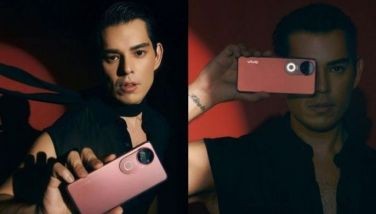The dance of genius
July 22, 2004 | 12:00am
I was a very young woman then who accompanied a physicist to a gathering of the most interesting and creative characters in that big living room in an old Malate house one night, many years ago. A poet graciously hosted that night where also sat a novelist, an architect, a dancer and a politician who for his own good, temporarily found his better, less self-indulgent side and lost himself then in piano-playing. While I felt like an impostor that evening, or some kind of voyeur to genius, it was also one of those defining moments in my learning where I clearly remember telling myself that whatever it is I decided to do for the rest of my life, I wanted it to be fueled by whatever made these kinds of people’s choice of life dances so joyful and complete. I noted that they all came from fields as varied as the ingredients in the buco salad extraordinaire that the poet, our hostess, specialized in, but what common process of the mind did they all share that could gather them all in one night and make this gathering so exquisitely creative and delicious like the buco salad we were served in those little holy grail brass goblets?
Creativity. They were all compelled to create and recreate. And they churned them out: theories, formula, poetry, design, song, fiction, metaphors, lyrics and dance movement, with every breath they made and let out. They needed to be creative in the way they discovered the world with the tools and tendencies with which their minds and bodies were uniquely endowed. They made it a craft to discover a piece of the world or a morsel of life and they rendered it back to the rest of us, transformed. And with the music, words, designs, theories and swing they breathed out to us, we were never the same afterwards.
That odd group in Malate was probably not even conscious of the mindful process that united them all which I was trying to tease out for myself that night. They did not reflect on it over dinner but I would have loved to hear them discuss among themselves how creativity was born, shaped, realized and inspired across the sciences and the arts. But I was probably pushing my luck. An excellent dinner and such joyful, musical company were already far more than any impostor like me could ask for. But this year, though with a different set of characters, I sort of got my wish.
Sometime last May, the Rockefeller University hosted a roundtable gathering of acclaimed artists and scientists to ask them about the common element in their diverse lives, which is creativity. Entitled "Compelled to Create? Artists and scientists on the process of discovery." Hosted by science writer and commentator Ira Flatow, it featured Wendy Wassertein; Ursula von Rydingsvard, sculptor; Sarah Sze, installation artist; David Small, information designer; and Titia de Lange, cell biologist. This is what I teased out of their discussion on creativity.
First, it is important that one’s childhood be encouraged toward creativity. No one person or institution should define what is "creative" for a child. She or he should be able to explore as many options of worlds as possible. The sculptor Rydingsvard said that it is important that a child not be "programmed to death" but rather, tremendously stimulated and encouraged to openly participate in "making" things whether the material is clay, oil, paint, words or notes. They should even be allowed to be bored so that they can imagine for themselves things they can do. Playwright Wendy Wassertein’s imagination was encouraged by her parents that even if she did not possess the features of the stereotypical image of a stage queen, she found her way to the foundational creativity in plays: writing it. The roundtable also acknowledged that just as there are teachers who block our creativity, there are those who push the barriers and they are the ones whom we should encourage to help children.
Second, that once you realize what craft you have fallen in love to be creative with, you have to be ready to meld the elements of discipline and the willingness to learn and perfect the techniques required in your field. Cell biologist Titia de Lange raised the importance of these techniques, especially in the natural sciences, where experimental methods would have to be creatively suited for the question in Nature they are trying to probe. Discipline in the natural sciences requires patience and long hours of labor in laboratories and computations. Playwright Wassertein forcibly apportions for herself a specific time and corner in her house where she has to face the voices in her head to write her play.
Third, creativity renders you willing to be embarrassed but resilient. Titia de Lange stated this to be so true in the natural sciences where you are humbled because most of the time, your results prove your initial guesses to be wrong and that is how the sciences grow. In the sciences, they do not have the equivalent of the literary critic or political commentator to critique their work. They have each other – their peers in their respective fields. The willingness there is for them to accept that they thrive in a transparent community of scientific minds. For the sculptor and installation artists, they said that to be embarrassed in pursuit of creativity means you should recognize that as an artist, you are breathing life into an object, and each move may or may not come close to what that life is so that you should accept these mental flirtations may not always be successful. It is important that you move on and not carry your negativity to your next work.
Fourth, that creativity yields only a piece of insight into Nature, a tentative piece of Nature since no one work can encapsulate the entire mystery of Nature in all its seasons. Thus, the playwright, in her dialogues, explores aspects of human nature. The sculptors record and breathe life into objects by shaping them. The digital information scientist captures some bytes of the dialogue between human and artificial intelligence and the cell biologist, what happens to "legs" of chromosomes in the cell division that governs the rhythm of our cellular lives. No one creative act is sweeping enough to explain all of life, natural or experienced, but to be creative is to enter into it, even just a tiny portion of it, and make it dance.
Lastly, creativity should be encouraged and supported by society in terms of resources, time, space and freedom. This is the scale at which we recognize the transformative power of creative genius. This is the scale where we not only personally admire their creativity but also harness them so we can, as a society, get on with the process of discovery in the arts and the sciences to make our lives better, more meaningful and even joyful.
At the end of that Malate night, I heard the novelist sing that Cole Porter song: "You do that voodoo that you do so well." I replied in a whisper, "No sir, you do. You do that voodoo so well. Thank you."
For comments, e-mail dererumnatura@mydestiny.net.
Creativity. They were all compelled to create and recreate. And they churned them out: theories, formula, poetry, design, song, fiction, metaphors, lyrics and dance movement, with every breath they made and let out. They needed to be creative in the way they discovered the world with the tools and tendencies with which their minds and bodies were uniquely endowed. They made it a craft to discover a piece of the world or a morsel of life and they rendered it back to the rest of us, transformed. And with the music, words, designs, theories and swing they breathed out to us, we were never the same afterwards.
That odd group in Malate was probably not even conscious of the mindful process that united them all which I was trying to tease out for myself that night. They did not reflect on it over dinner but I would have loved to hear them discuss among themselves how creativity was born, shaped, realized and inspired across the sciences and the arts. But I was probably pushing my luck. An excellent dinner and such joyful, musical company were already far more than any impostor like me could ask for. But this year, though with a different set of characters, I sort of got my wish.
Sometime last May, the Rockefeller University hosted a roundtable gathering of acclaimed artists and scientists to ask them about the common element in their diverse lives, which is creativity. Entitled "Compelled to Create? Artists and scientists on the process of discovery." Hosted by science writer and commentator Ira Flatow, it featured Wendy Wassertein; Ursula von Rydingsvard, sculptor; Sarah Sze, installation artist; David Small, information designer; and Titia de Lange, cell biologist. This is what I teased out of their discussion on creativity.
First, it is important that one’s childhood be encouraged toward creativity. No one person or institution should define what is "creative" for a child. She or he should be able to explore as many options of worlds as possible. The sculptor Rydingsvard said that it is important that a child not be "programmed to death" but rather, tremendously stimulated and encouraged to openly participate in "making" things whether the material is clay, oil, paint, words or notes. They should even be allowed to be bored so that they can imagine for themselves things they can do. Playwright Wendy Wassertein’s imagination was encouraged by her parents that even if she did not possess the features of the stereotypical image of a stage queen, she found her way to the foundational creativity in plays: writing it. The roundtable also acknowledged that just as there are teachers who block our creativity, there are those who push the barriers and they are the ones whom we should encourage to help children.
Second, that once you realize what craft you have fallen in love to be creative with, you have to be ready to meld the elements of discipline and the willingness to learn and perfect the techniques required in your field. Cell biologist Titia de Lange raised the importance of these techniques, especially in the natural sciences, where experimental methods would have to be creatively suited for the question in Nature they are trying to probe. Discipline in the natural sciences requires patience and long hours of labor in laboratories and computations. Playwright Wassertein forcibly apportions for herself a specific time and corner in her house where she has to face the voices in her head to write her play.
Third, creativity renders you willing to be embarrassed but resilient. Titia de Lange stated this to be so true in the natural sciences where you are humbled because most of the time, your results prove your initial guesses to be wrong and that is how the sciences grow. In the sciences, they do not have the equivalent of the literary critic or political commentator to critique their work. They have each other – their peers in their respective fields. The willingness there is for them to accept that they thrive in a transparent community of scientific minds. For the sculptor and installation artists, they said that to be embarrassed in pursuit of creativity means you should recognize that as an artist, you are breathing life into an object, and each move may or may not come close to what that life is so that you should accept these mental flirtations may not always be successful. It is important that you move on and not carry your negativity to your next work.
Fourth, that creativity yields only a piece of insight into Nature, a tentative piece of Nature since no one work can encapsulate the entire mystery of Nature in all its seasons. Thus, the playwright, in her dialogues, explores aspects of human nature. The sculptors record and breathe life into objects by shaping them. The digital information scientist captures some bytes of the dialogue between human and artificial intelligence and the cell biologist, what happens to "legs" of chromosomes in the cell division that governs the rhythm of our cellular lives. No one creative act is sweeping enough to explain all of life, natural or experienced, but to be creative is to enter into it, even just a tiny portion of it, and make it dance.
Lastly, creativity should be encouraged and supported by society in terms of resources, time, space and freedom. This is the scale at which we recognize the transformative power of creative genius. This is the scale where we not only personally admire their creativity but also harness them so we can, as a society, get on with the process of discovery in the arts and the sciences to make our lives better, more meaningful and even joyful.
At the end of that Malate night, I heard the novelist sing that Cole Porter song: "You do that voodoo that you do so well." I replied in a whisper, "No sir, you do. You do that voodoo so well. Thank you."
BrandSpace Articles
<
>
- Latest
Latest
Latest
April 28, 2025 - 6:22am
April 28, 2025 - 6:22am
March 28, 2025 - 10:50am
March 28, 2025 - 10:50am
March 25, 2025 - 10:30am
By May Dedicatoria | March 25, 2025 - 10:30am
March 20, 2025 - 3:52pm
March 20, 2025 - 3:52pm
Recommended































